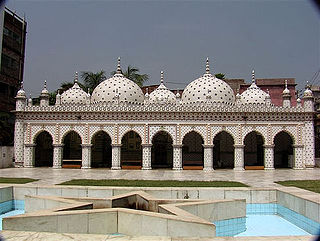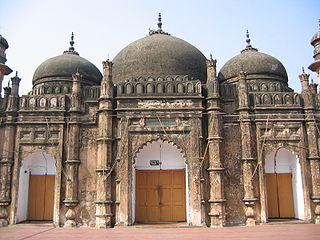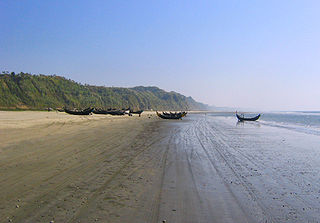
Dhaka, formerly known as Dacca, is the capital and largest city of Bangladesh, as well as the world's largest Bengali-speaking city. It is the eighth largest and sixth most densely populated city in the world with a population of 8.9 million residents as of 2011, and a population of over 21.7 million residents in the Greater Dhaka Area. According to a Demographia survey, Dhaka has the most densely populated built-up urban area in the world, and is popularly described as such in the news media. Dhaka is one of the major cities of South Asia and a major global Muslim-majority city. As part of the Bengal delta, the city is bounded by the Buriganga River, Turag River, Dhaleshwari River and Shitalakshya River.

The Sixty Dome Mosque, is a mosque in Bagerhat, Bangladesh. It is a part of the Mosque City of Bagerhat, a UNESCO World Heritage Site. It is the largest mosque in Bangladesh from the sultanate period (1352–1576). It was built during the Bengal Sultanate by Khan Jahan Ali, the governor of the Sundarbans. It has been described as "one of the most impressive Muslim monuments in the whole of South Asia."

Star Mosque, is a mosque located in Armanitola area, Dhaka, Bangladesh. The mosque has ornate designs and is decorated with motifs of blue stars. It was built in the first half of the 19th century by Mirza Golam Pir.

Bara Katra, a historical and architectural monument, is one of the oldest buildings in Dhaka. The word Katra may have originated from Arabic word Katara which means colonnaded building. 'Katra/ katara' in Arabic and Persian means 'Caravan (Karwan) Sarai' or simply a 'Sarai'. It is a palatial building dating to the reign of the Mughal dynasty in the Bengal region. It is situated to the south of Chowk Bazaar close to the north bank of the river Buriganga.
Sutrapur is a Thana of Dhaka District in the Division of Dhaka, Bangladesh.

The Khan Mohammad Mirza Mosque is a historical mosque near Lalbagh Fort in Dhaka, Bangladesh.

The Wari-Bateshwar ruins in Narsingdi, Dhaka Division, Bangladesh is one of the earliest urban archaeological sites in Bangladesh. Excavation in the site unearthed a fortified urban center, paved roads and suburban dwelling. The site was primarily occupied during the iron age, from 400 to 100 BCE, as evidenced by the abundance of punch-marked coins and Northern Black Polished Ware (NBPW) artifacts.

Bangladesh's tourist attractions include historical monuments, resorts, beaches, picnic spots, forests and tribal people, wildlife of various species. Activities for tourists include angling, water skiing, river cruising, hiking, rowing, yachting, and sea bathing.

Architecture of Bangladesh is intertwined with the architecture of the Bengal region and the broader Indian subcontinent. The architecture of Bangladesh has a long history and is rooted in Bangladesh's culture, religion and history. It has evolved over centuries and assimilated influences from social, religious and exotic communities. The architecture of Bangladesh bears a remarkable impact on the lifestyle, tradition and cultural life of Bangladeshi people. Bangladesh has many architectural relics and monuments dating back thousands of years.

Northbrook Hall was originally built as a town hall during the British period. It is situated at Farashgonj road in Old Dhaka, Bangladesh, on the north bank of the Buriganga River.

Shahbaz Khan Mosque is a historic mosque located in Dhaka, Bangladesh. Located near Mir Jumla’s Gate, this mosque serves as an example of late Mughal architecture in Bengal, known as the Shaista Khan architectural style.

The Dhanmondi Shahi Eidgah, also known as Mughal Eidgah, is located in Saat Masjid road, in Dhanmondi residential area of Dhaka, Bangladesh. The Eidgah was built in 1640 CE during the Mughal era and has been in use for Eid celebration since then.
Archbishop House also known as Kakrail Church is an architecturally significant residence and church situated in Kakrail, Ramna Thana, Dhaka, Bangladesh. It was first built in 1925, with a chapel on the east end. It had evolved 1947 in Lakkibazar and in 1957 it transferred to Kakrail. The present church was renovated in 1976. There are Gothic and Renaissance motifs inside and outside the structure and it is considered to be a fine example of post colonial fusion architecture. The Daily Star reported in 2009 that official listing as a national heritage site was imminent, but six years later the Department of Archaeology was still preparing the list of buildings to be preserved.

The Armenian Church, also known as Armenian Apostolic Church of the Holy Resurrection, is a historically significant architectural monument situated in the Armanitola area of old Dhaka, Bangladesh. The church bears testimony to the existence of a significant Armenian community in the region in the 17th and 18th centuries.

The Singar Mosque is a 15th-century mosque which is part of the Mosque City of Bagerhat, a World Heritage Site in south-western Bangladesh. It is a single-domed, square building of exposed brick with terracotta decorations.

The Goaldi Mosque is a mosque in the historic Bengali capital of Sonargaon. It was built during the Bengal Sultanate under the reign of Sultan Alauddin Hussain Shah. It is one of the few surviving medieval monuments in Sonargaon Upazila, Bangladesh.

Lalbagh Fort is an incomplete 17th-century Mughal fort complex that stands before the Buriganga River in the southwestern part of Dhaka, Bangladesh. The construction was started in 1678 AD by Mughal Subahdar Muhammad Azam Shah, who was a son of Emperor Aurangzeb and later emperor himself. His successor, Shaista Khan, did not continue the work, though he stayed in Dhaka up to 1688.
Department of Archaeology is one of the government agency of Bangladesh. By the Laws of Archaeology 1964 this agency maintains the conservation and preservation of archaeological sites in the country. Since 2013, the department has been running its activities from the Administration Building situated in Agargaon in Dhaka.

The historical shrine of Dayera Sharif Khanqah, commonly known as Bara Dayera Sharif, is situated in the Azimpur locality of Dhaka city. The Persian word Dayera means "circle" or "work area". As a rule, the heirs of the Dayera Sharif never go outside the area, except for pilgrimage. The Azimpur Dayera Sharif was established by Shah Sufi Sayed Muhammad Dayem who came at Dhaka in 1766-68 AD. It is currently under the supervision of his saventh generation(tenth Gaddi-Nashin). Shah Sufi Syed Ahmadullah Jobayer has been the overall supervisor of Dayera Sharif since 1998. The successor of the Sufi dynasty is known as Gaddi Nashin, who sits on the Gaddi to serve people.





























